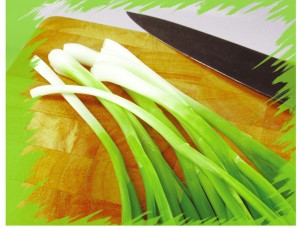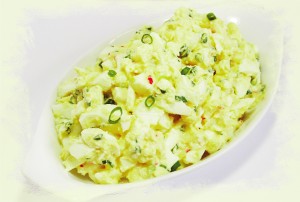By Cynthia Nelson
Hi Everyone,
They are onions alright, though some say they are immature, perhaps it’s because a single name cannot be ascribed to them. Take your pick: green onions, shallots, chives, seasoning, spring onions, eschallots, or scallions? Immature or not, I love them very much. Their tender stalks, beautiful white and purple heads, along with their gentle onion flavour and heady aroma make me fall in love every time I use them. And what name do I call these things I love? Well it depends on where I am and from whom they are purchased.
 Here in Barbados at the farmers’ market, if I am purchasing them from a Barbadian vendor, I have to refer to them as seasoning. If I am purchasing them from a Guyanese vendor, I say shallots; if from the supermarket, I look for chives or scallions and if I am in the United States, green onions are what I purchase. If I were still in Mrs. Cummings’ English Class, I’d have to refer to them as eschallots. For the sake of this column, we are going to refer to them as green onions. But not all green onions are equal as we will see later.
Here in Barbados at the farmers’ market, if I am purchasing them from a Barbadian vendor, I have to refer to them as seasoning. If I am purchasing them from a Guyanese vendor, I say shallots; if from the supermarket, I look for chives or scallions and if I am in the United States, green onions are what I purchase. If I were still in Mrs. Cummings’ English Class, I’d have to refer to them as eschallots. For the sake of this column, we are going to refer to them as green onions. But not all green onions are equal as we will see later.
Green onions are ubiquitous in many cuisines, particularly in Asian cuisines. Often used as a garnish, for colour, for freshness or their delicate flavour, many kitchens are never without these herbs. But what exactly is a green onion?
The green onion is a member of the Allium family and Allium is the onion genus which has about 1,250 species. The green onion lacks a fully-developed bulb which is why it is sometimes called an immature onion. While the names scallion, eschallot, spring onion or even salad onion can be applied to the green onion, chives are definitely a different species altogether. Chive stalks are much more tender, very slender in appearance and even milder in flavour and they don’t have any white parts as they shoot from the ground in a tight cluster. When sold, they are either sold in the container in which they grew or held together with rubber bands with their tops cut from the root.
In North America, Europe and other places, shallots are also different. Shallots in these cases are like small onions and for those of you familiar with the purple-head green onions that we get sometimes, think of the purple heads by themselves, only larger with a papery-casing. These are expensive (especially here in the Caribbean. I saw some at one of the superstores for US$15 per pound!). Many chefs use them because of the milder, sweeter flavour and because they can breakdown more easily than an onion. Another plus for the shallot is that you won’t cry as much as when you cut up an onion.
 As I said in the beginning, I love green onions and use them all the time, as an ingredient and as a garnish. I cannot imagine my sardines without sliced green onions, nor my eggplant choka, scrambled eggs, fried rice, chowmein, potato choka, soups or egg salad. I’ve recently found myself grilling them whole also, they’re so good! Oh they’re great in salads too. On some cooking shows on television I see some people only using the white parts or the green parts, me, I use the whole thing! Actually, I noticed that most vendors at the market here in Barbados sell their green onions with the top parts cut off. I stay clear of those, I want the heads too.
As I said in the beginning, I love green onions and use them all the time, as an ingredient and as a garnish. I cannot imagine my sardines without sliced green onions, nor my eggplant choka, scrambled eggs, fried rice, chowmein, potato choka, soups or egg salad. I’ve recently found myself grilling them whole also, they’re so good! Oh they’re great in salads too. On some cooking shows on television I see some people only using the white parts or the green parts, me, I use the whole thing! Actually, I noticed that most vendors at the market here in Barbados sell their green onions with the top parts cut off. I stay clear of those, I want the heads too.
I like the fact that green onions are available all year round and they grow so easily and require little maintenance. If you plant some today, in two days you start to see them shooting up. I never overcook green onions; I always add them just as the dish I am making is finishing up. This way, they retain their colour and the white parts have a little crunch. If using in a recipe, I always advise people to stir-in the green onions. In terms of garnishing, they really make for great presentation. The white tops can be sliced lengthways, soaked in iced water for some time which results in the cuts curling back to form beautiful flowers. Cutting the green parts on a bias is an attractive cut that works well too, especially in stir-fries. I like the simple thinly sliced round cuts best of all, makes for easy scattering and decorating.
My preference in purchasing green onions is always to get the ones with the purple heads but alas, that is a rarity here in Barbados. There are only two vendors at the farmers’ market I go to that sell them. One of them would only have green onions twice a year and while the other has them a bit more often, the green parts on his are not always attractive; and because he is the only one with that variety, you don’t want me to tell you how much he charges! And so with such limited offers of the purple-head green onions, I’ve given my full attention to the white-headed variety which is also very good.
If you’ve only ever used green onions to make seasoning (ground up with onions, garlic, peppers and other herbs), you don’t know what you’re missing. Try slicing them thinly and adding them to your soups, stews, rice dishes, salads, seafood dishes etc just as they are about to finish cooking or even sprinkle some of it on top of your food. Try it and tell me you don’t like it.
Cynthia
tasteslikehome@gmail.com
www.tasteslikehome.org





